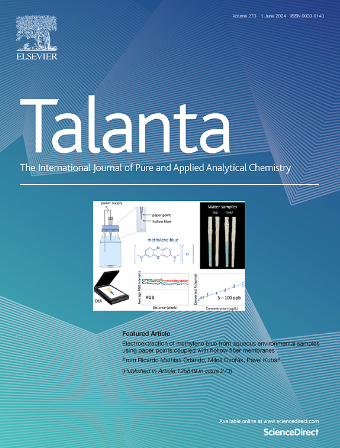基于聚l-cys/Cu NCs的新型蛋白质冠状诱导聚集- ecl策略用于检测水中微塑料。
IF 6.1
1区 化学
Q1 CHEMISTRY, ANALYTICAL
引用次数: 0
摘要
为了解决微塑料(MPs)带来的健康风险,本工作开发了一种基于聚l-半胱氨酸(poly-L-cys)的电化学发光(ECL)传感器,用于检测水环境中的MPs。聚l -胱氨酸膜的多孔结构可以调节孔隙中铜纳米簇(Cu NCs)的生成,有效地限制了纳米颗粒的迁移和聚集。此外,poly-L-cys薄膜还作为助反应促进剂,促进电子转移,有效增强Cu NCs的ECL信号。因此,Cu - NCs在聚l -cys多孔膜中被用作发光探针。利用蛋白冠诱导聚集效应(protein corona induced aggregation effect, PCIAE)构建了聚l -cys/Cu - ncs型ECL传感器,用于测定MP的浓度。由于PCIAE具有较强的结合亲和力,MP可以作为蛋白冠强烈吸附在生物分子表面。因此,聚l -cys膜上修饰的BSA被MP去除,导致ECL信号增强。PCIAE-ECL传感器已成功应用于湖泊中MP的测量,回收率为90.7 ~ 106.0%。PCIAE-ECL传感器为水环境中MPs的检测提供了一种新的分析方法。本文章由计算机程序翻译,如有差异,请以英文原文为准。

A novel protein corona-induced aggregation-ECL strategy based on poly-l-cys/Cu NCs for detecting microplastics in water
To address the health risks posed by microplastics (MPs), this work developed a poly-l-cysteine (poly-L-cys)-based electrochemiluminescence (ECL) sensor for detecting MPs in water environments. The porous structure of poly-L-cys film can regulate the generation of copper nanoclusters (Cu NCs) in the pores, effectively limiting the migration and aggregation of nanopaticles. In addition, poly-L-cys film also acted as co-reactant promoters, promoting electron transfer and effectively enhancing ECL signal of Cu NCs. Therefore, Cu NCs in the poly-L-cys porous membrane has been used as luminescent probes. Furthermore, the poly-L-cys/Cu NC-based ECL sensor was constructed with the protein corona induced aggregation effect (PCIAE) to determine the concentration of MP. Due to the strong binding affinity of PCIAE, MP can adsorb strongly to biomolecule surfaces as a protein crown. So, the modified BSA on the poly-L-cys film was removed by MP, resulting in the ECL signal enhancement. The PCIAE-ECL sensor has been successfully applied to measure MP in lakes with excellent recovery rates (90.7–106.0 %). The PCIAE-ECL sensor provided a new analytical method for detecting MPs in water environments.
求助全文
通过发布文献求助,成功后即可免费获取论文全文。
去求助
来源期刊

Talanta
化学-分析化学
CiteScore
12.30
自引率
4.90%
发文量
861
审稿时长
29 days
期刊介绍:
Talanta provides a forum for the publication of original research papers, short communications, and critical reviews in all branches of pure and applied analytical chemistry. Papers are evaluated based on established guidelines, including the fundamental nature of the study, scientific novelty, substantial improvement or advantage over existing technology or methods, and demonstrated analytical applicability. Original research papers on fundamental studies, and on novel sensor and instrumentation developments, are encouraged. Novel or improved applications in areas such as clinical and biological chemistry, environmental analysis, geochemistry, materials science and engineering, and analytical platforms for omics development are welcome.
Analytical performance of methods should be determined, including interference and matrix effects, and methods should be validated by comparison with a standard method, or analysis of a certified reference material. Simple spiking recoveries may not be sufficient. The developed method should especially comprise information on selectivity, sensitivity, detection limits, accuracy, and reliability. However, applying official validation or robustness studies to a routine method or technique does not necessarily constitute novelty. Proper statistical treatment of the data should be provided. Relevant literature should be cited, including related publications by the authors, and authors should discuss how their proposed methodology compares with previously reported methods.
 求助内容:
求助内容: 应助结果提醒方式:
应助结果提醒方式:


